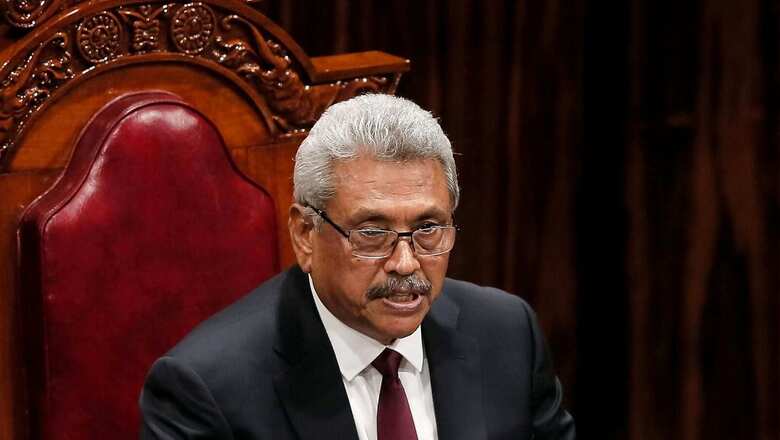
views
Once again, much has been written about the recently reported upheaval in Sri Lanka’s China relations and the nation’s strategic tilt towards the larger Indian neighbour. Going by Colombo’s track record even in the short span of 21st century, independent of the party or leadership in power, it would continue to try and balance India and China relations. In geopolitical terms, it is often described as playing China and India against each other, leveraging on Sri Lanka’s locational advantage.
Sri Lanka’s relations with China are old, though they cannot be described as equal to the umbilical cord relations that geography first and history since had established centuries before the Cold War and post-Cold War geostrategic, geopolitical and geoeconomic dynamics began dictating intra-regional relations in South Asia, extending into the shared Indian Ocean, where there are other partners, players and claimants. Muscle-power and money-power dictate the second and direct the last one.
China argues, rather forcefully, that South China and East China Seas are its backwaters to the exclusion of other nation-states in the region, and extra-regional powers like the US, even more. If Beijing suffers from the US and the rest, who argue the case of ‘freedom of navigation’, citing UN legislations and resolutions, it’s only because it suits China in its hour of economic expansionism and dominance. It does not want to extend the courtesy or logic to India, viz Indian Ocean, for reasons whose history is less than a century old.
In this background, Sri Lanka’s India equations, especially of the majority Sinhala-South, have been Yo-Yo relations at best. They will talk about how India gave them Buddhism, and in the same vein recall Rajaraja Chola’s invasion of the island a thousand years ago. They recall how a younger southern Sinhala king, Dutugamnu, trounced septuagenarian Tamil ruler, Ellara, but would jump two millennia to claim how LTTE’s Prabhakaran’s choice of Tiger/Tigers as the emblem and name for his terror-outfit drew from the Chola standard and how all of it found reflection in contemporary Indian state’s approach to the ‘ethnic issue’ in their midst.
Yo-yo Relations
To speculate on contemporary triangular relations, particularly in the context of the recent Colombo decision to reject infected organic fertiliser and China black-listing the Sri Lankan public bank payment-guarantor for not clearing their bills of its exporter, is a little too far-fetched. In a way, it reflects the yo-yo nature of the triangular relationship. Otherwise, it, in essence, sums up the Indian strategic thinking about Sri Lanka, which has always been predicated on the nation’s regional/global adversary of the time, namely, the US during the Cold War, China post-Cold War and Pakistan, since the nation’s creation.
The Hambantota port deal is a case study of Sri Lanka’s disposition towards China. Indian strategic community blamed and those in government continue to blame the ruling Rajapaksas of the period, and also at present, for the Hambantota construction-cum-concession deal, and not revoking the same despite a poll promise in 2019. They either forget or conveniently side-step how the predecessor government of president Maithripala Sirisena and prime minister Ranil Wickremesinghe, with the latter in greater parliamentary control, converted such a contract into a 99-year-lease, purportedly blaming the earlier regime of president Mahinda Rajapaksa for pushing the nation into a China-centric debt-trap. It was a trap of an argument in which the international community/strategic community, starting with the all-knowing Indians, comfortably got themselves trapped.
In a nutshell, Sri Lanka as a nation decides what it thinks suits best for itself. There is a kind of national consensus over it, barring of course the minority Tamil community that has been fighting for ethnic equality for decades now. Even here, the Sinhala-Buddhists believe that the Tamils want to restore their ethnic superiority, which they would not accept. They leverage their numbers in a nation where electoral democracy made its beginning in these parts of the world, as far back as 1931. This has led to war, violence and the LTTE brand of terrorism, but with nothing achieved.
All this, the tactically-superior Sinhala-Buddhist polity have proved to their constituency, was India-inspired, or at least India-aided. Against this, the Tamil minority, which had benefitted from the Indian political and strategic initiatives in the past decades, are a divided lot when it came to backing New Delhi to the hilt, in domestic politics. The LTTE thought otherwise and acted otherwise. To date, there is unanimity in the matter, as India is still wedded to the idea of ‘Tamil equality within a united Sri Lanka’. The Sinhalas do not want to trust New Delhi on its word, and their competitive political leaderships keep packaging it differently, but to the same end as far as India relations go.
Under the present circumstances prevailing in Sri Lanka, it suited China’s strategic intent to let Indians believe that the other two were caught in a political fight over Beijing’s supply of organic fertilisers to the island nation, and the latter denying/delaying payment, citing poor quality. It is anybody’s guess if Sri Lanka had named the barred microbes that should not be present in the Chinese exports, to be able to win an international arbitration.
That apart, by giving the impression that it was distancing from Sri Lanka in its hour of dire economic crisis, and counter-acting the ground realities by demanding payment for the fertiliser that Colombo would not accept, Beijing might have created an illusion for Indians to believe. It has only used the arm-twisting to gain greater strategic concessions than ever in the past viz India. The more recent Jaffna visit of China’s Sri Lankan envoy, Amb Qi Zhenhong, when he offered worship at the famed Nallur Murugan temple of the Tamil-Hindu community in the North, visited the iconic Jaffna Library which Sinhala-Buddhist chauvinists imported from Colombo gutted in 1991, distributed $100,000 worth of assistance to local fishers affected by ‘poaching’ by Indian counterparts, took a boat-ride closer to the IMBL between the two South Asian neighbours and flew drones into the sea-skies in those parts, all have to be seen in this context.
Especially the latter ones, which is both unprecedented and provocative vis-à-vis India, and for which the Sri Lankan government had granted permission and facilitated, by letting the Chinese delegation use the navy’s speed-boat(s)!
The writer is Distinguished Fellow and Head-Chennai Initiative, Observer Research Foundation, the multi-disciplinary Indian public policy think-tank, headquartered in New Delhi. The views expressed in this article are personal and do not represent the stand of this publication.
Read all the Latest Opinions here




















Comments
0 comment